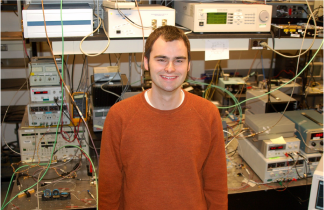 (Above: Setup of the metalens (soda cans) used to focus a sound wave to a size of 1/25 th of the wavelength of the waves used to generate the beam)
(Above: Setup of the metalens (soda cans) used to focus a sound wave to a size of 1/25 th of the wavelength of the waves used to generate the beam)Professor Mathias Fink from ESPCI ParisTech and Institut Langevin doesn't fit the typical profile for a plenary speaker at an optics conference, which is precisely why why you won't want to miss his plenary talk at CLEO 2012 this May. Though acoustics is the consistent medium for his work, his research more broadly consists of understanding the nature of waves and how to get around the limits assumed by our conventional understanding, such as diffraction-limited focusing and imaging. Much of professor Fink's work since the late 1990's has been using time-reversal, the subject of his upcoming plenary talk, to achieve these ends.
For example, in the August 5, 2011 issue of Physical Review Letters, Fink and collaborators demonstrated that they could focus a sound wave to 1/25 th of the wavelength of the waves used to create the focused beam. Ironically, this novel feat was obtained using very conventional objects- soda cans and computer speakers.
The MacGyveresque experiment shown in the figure above uses a grid of soda cans, a group of subwavelength acoustic resonators, to act as a "metalens". When illuminated with a broadband field, this metalens allows subwavelength detail in the near-field to be encoded onto propagating waves. Essentially the metalens is a very good evanescent-to-propagating-wave converter, "unsticking" evanescent waves with subwavelength detail that are typically locked to the surface of the object (or source) of interest. This phenomenon is analogous to the generation of surface plasmons in near-field microscopy (see the August 16th post below). The propagating waves, now containing subwavelength information, can be detected in the far-field and time-reversed (essentially run backwards) in order to focus to subwavelength spots.
Time-reversal essentially amounts to phase-conjugation. However, unlike optical phase conjugation, time-reversal is broadband. Rather, time-reversal is phase conjugation for every frequency at once.
In order to experimentally employ time-reversal, one needs a time-reversal mirror (TRM). For an acoustic wave, a TRM is essentially an array of piezoelectric transducers spread over a surface through which the wave of interest propagates. Each transducer records the wave at its unique position and then is made to play back the time-reversed copy such that the each wave retraces its complex path back to the source. Professor Fink and collaborators first demonstrated the power of time-reversal in the mid 1990's when they focused sound to a much smaller spot size than allowed by the aperture of the transducer array producing it. They discovered that when the source was allowed to scatter many times off of a random array of steel rods, they could reverse the signal such that it came back to a smaller spot size than the original source. The long path lengths from multiple scattering effectively widened the focusing aperture. When they removed the steel rods, they could only focus to the predicted size limited by the aperture of the transducer array.
In a 1997 physics today article, Fink explains time-reversal using an analogy of an exploding block:
"If we want to reconstruct an exploded block from the various scattered pieces, a time-reversal mirror would be a device that precisely reverses the velocity of each debris particle as it crosses a closed surface surrounding the initial block. But before being sent back, each particle must be held for an appropriate delay time: To reconstitute the block, one has to send back first the slowest pieces, which had arrived last."
Time-reversing an exploding block is of course thermodynamically impossible, however, for waves which can be described completely by a limited amount of information, it is reality. The strangeness of the multiple scattering experiment performed by Fink et al in the 1990's, and current experiments, is that it is as if the exploding block is being time-reversed to be put back together into a block that is smaller than the original.
So what about time-reversal for optics? Subdiffraction focusing and imaging in the optical domain have already been shown using a variety of techniques without time-reversal (for example, see Frank Kuo's September 10th post). However, two recent articles by McCabe et al, and Vellekoop et al show the optical analog of Fink's 1990's work, in which a highly scattering medium combined with time-reversal (via spatial light modulators) can be used to enhance an optical focus. Another recent work by Xu et al from Washington University shows a technique called Time-Reversed Ultrasonically Encoded (TRUE) focusing in which only the encoded portion of light from a microscope focal volume is time-reversed back to the sample for clean focusing. In this case the time-reversal mirror consists a holographic technique using a photorefractive crystal to a phase-conjugate of the right bit of light back to the focus.
I'm not only looking forward to Fink's plenary talk to learn about other uses of time-reversal in optics, but to generate ideas of what other wave phenomena may be borrowed from fields like acoustics, microwave communication, and quantum mechanics and visa-versa. After all, it's just the same wave equation.
